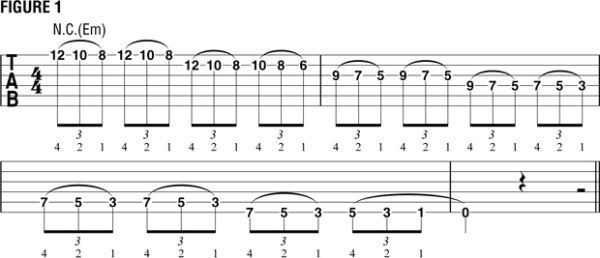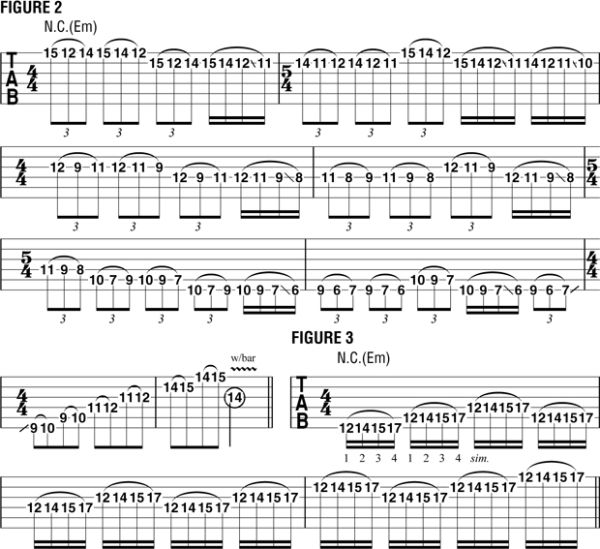How Guitarists Can Build Super-Human Legato Chops
Get your fret-hand chops in shape and develop excellent fretboard “traction” with this lesson.
An essential element in soloing for all guitarists is the use of legato techniques.
The term legato is defined as “smooth and connected,” and a legato sound is generally achieved on the guitar through the incorporation of hammer-ons, pull-offs and finger slides.
In most of my previous columns, we have focused on pick-hand techniques involving downstrokes, upstrokes, alternate picking and economy picking.
This month, I’ve designed a series of exercises to get your fret-hand chops in shape and develop excellent fretboard “traction.”

In FIGURE 1, I play repeated descending figures based on the E Phrygian mode (E F G A B C D), sticking with a steady rhythm of eighth-note triplets. Each eighth-note triplet incorporates a double pull-off. On beat one, I start with my fret-hand pinkie on the high E string’s 12th fret and pick that note with a downstroke. I then pull off to the 10th fret, fretted with the middle finger, followed by an additional pull-off to the eighth fret, fretted with the index finger.
As you can see, a wide stretch is required to execute these double pull-offs, so position your fret-hand thumb squarely on the back of the neck to allow as great a reach as possible with the fretting fingers. Work through each group of notes carefully, and then focus on making clean position shifts down the fretboard as the riff progresses.
When pulling off, it is essential that the note you’re pulling off to is fretted in advance, or “pre-fretted,” so as to be ready to “catch” the pull-off. Also, as you pull off, you’ll need to literally pull the string slightly sideways, in toward the palm, as you release it. This will ensure a sufficient amount of volume and projection.

FIGURE 2 raises the bar, so to speak, in a variety of ways. First, the example is not based on any specific scale; rather, it’s built from symmetrical fretboard patterns that move across all of the strings. I begin on beat one with a pull-off/hammer-on eighth-note triplet shape followed by a straight double pull-off. I then alternate between these two melodic “cells” as the riff progresses, with some quick descending slides thrown in at the end of each bar to accommodate the many position shifts.
Again, work through the figure slowly and strive for an even and clean execution of the pull-offs, as well as the shifts.
Our final example, shown in FIGURE 3, is purely symmetrical throughout: ascending across three adjacent strings repeatedly, I use a wide fret-hand stretch to sound four notes per string, starting on the sixth string and followed by the fifth and fourth. I then move back to the fifth string and repeat the pattern, starting from the fifth string and moving up to the fourth and third.
This pattern is repeated across the remaining trios of adjacent strings. Remember that we’re picking only the first note on each string (to initiate the vibration) then using hammers and pulls to sound the subsequent notes. Make sure your hammer-ons are firm and strong, and practice the phrases slowly until you can execute them at shred speeds.
Get The Pick Newsletter
All the latest guitar news, interviews, lessons, reviews, deals and more, direct to your inbox!
“There are so many sounds to be discovered when you get away from using a pick”: Jared James Nichols shows you how to add “snap, crackle and pop” to your playing with banjo rolls and string snaps
Don't let chord inversions bamboozle you. It's simply the case of shuffling the notes around







![Joe Bonamassa [left] wears a deep blue suit and polka-dotted shirt and plays his green refin Strat; the late Irish blues legend Rory Gallagher [right] screams and inflicts some punishment on his heavily worn number one Stratocaster.](https://cdn.mos.cms.futurecdn.net/cw28h7UBcTVfTLs7p7eiLe.jpg)


